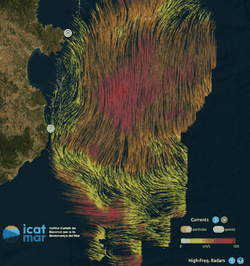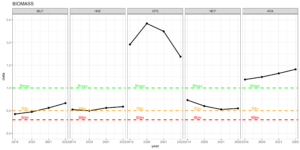We are launching new features for the ICATMAR fisheries data viewer. From now on, you can explore the data from the purse seine sampling. Additionally, we have incorporated improvements in size frequency comparisons and reorganized the viewer to facilitate data exploration.

The ICATMAR fisheries data viewer was launched in 2023, displaying data from bottom trawl sampling. Now, thanks to the viewer’s update it is possible, for the first time, to explore data from the purse seine modality. Just as was previously possible with bottom trawling, by clicking on one of the purse seine fishing operation on the map, you can view the catch composition of the selected fishing operation, indicating the biomass of the target species—sardines and/or anchovies—as well as other captured species. Additionally, through the integration of external data from Copernicus and EMODnet Seabed Habitats, you can also check the meteorological and oceanographic conditions at the time of the fishing and determine the type of marine habitat of the seabed where it was carried out.

During the sampling for both modalities, whether onboard fishing vessels or in the laboratory, either all individuals or a subsample of individuals from all captured species are measured. This data provides valuable information about population structures, enabling the study of species size distributions, including their approximate size range and the proportion of individuals of each size. With the previous version of the viewer, it was already possible to examine the size distributions of sampled species, but the new version allows for comparisons of species size distributions by year, season, métier, and zone. Additionally, for the size distributions of commercial species, the minimum conservation reference size (MCRS) and the size of first maturity (L50: the size at which 50% of individuals are considered to have reproduced for the first time) of the selected species are now displayed.
In Catalonia, the two main fishing modalities in terms of revenue and catch volume are bottom trawling and purse seine fishing, respectively. Since 2019, ICATMAR has conducted samplings onboard bottom trawling vessels. Onboard sampling provides highly detailed information about all aspects of a fishing trip, enabling the identification of the total catch composition (including both commercial and discarded species) and the collection of location data for each fishing operation and the maneuvers performed. Conversely, purse seine sampling initially consisted of acquiring lots of sardines and anchovies (the two target species of this modality) from various fish markets along the Catalan coast. This type of sampling, the fish market sampling, provided limited information about the fishery. However, starting in 2022, purse seine sampling was also conducted onboard commercial vessels. This has made it possible to access previously unavailable information about the fishery, which, after more than two years of data collection, is now publicly accessible through the updated viewer.
Looking ahead, the fishing data viewer will continue to incorporate new updates to make the information gathered through ICATMAR’s various monitoring programs available to everyone. Soon, it will also be possible to explore data obtained from monitoring recreational marine fishing in Catalonia, which has been ongoing since 2020. Stay tuned!














